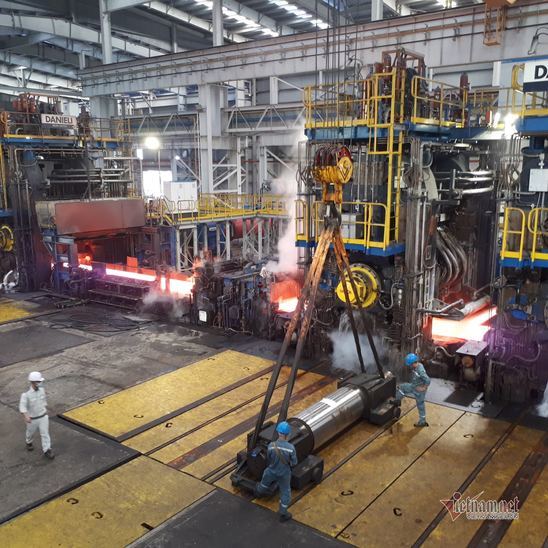Vietnam faces unexpected risks as global uncertainties continue
Vietnam’s economy has shown signs of recovery but the world is still reeling in the fight against Covid-19. As such, Vietnam needs to be well prepared for any upheaval.
Vietnam reported a GDP growth rate of 4.48 percent in the first quarter of 2021 compared with the same period last year, the same growth rate as the fourth quarter in 2020.
The World Bank (WB) said though the growth rate was still lower than that in the pre-pandemic period, it still reflects the ongoing recovery of the economy, despite the third Covid resurgence in northern provinces in February.
However, it noted that while the process is going strongly, the recovery is not equal in all business fields and the service sector remains depressed. Domestic demand has not fully recovered from the Covid-19 shock.
The institution said that Vietnam may experience new shocks or prolonged difficulties in some fields. Appropriate agencies should consider fiscal and monetary measures if the crisis continues and the national economy cannot recover as rapidly as planned.
If Vietnam can make breakthroughs in reform, it will see improvement in growth quality, and the average GDP growth rate could reach 6.76 percent per annum, according to the Central Institute of Economic Management (CIEM).
Meanwhile, the Vietnam Institute for Economic and Policy Research (VEPR) said that Vietnam is facing risks and challenges amid an uncertain global economic environment. The resurgence of Covid-19 in many countries, together with lockdowns, are prolonging the supply chain disruption, affecting the resiliency of businesses.
Geopolitical conflicts among large countries may expose economies with high openness, such as Vietnam’s, to unexpected risks.
According to VEPR, Vietnam’s economy faces internal risks, including fiscal imbalance; slow and low investment for development, especially investment in infrastructure, thus leading to low management efficiency; a vulnerable finance and banking system, despite recent improvements; heavy reliance on a foreign invested sector; lack of autonomy in technology and input materials; and low labor quality.
| According to VEPR, the most useful policies in the current situation are supply-side policies to reinforce economic fundamentals. |
However, VEPR believes that the establishment of the new Party and State apparatus, with the new government, promises a dynamic economic outlook in 2021 and afterwards.
Moreover, provided that the pandemic is controlled in Vietnam and the world’s economy begins recovering thanks to the gradual removal of blockades, VEPR predicts that Vietnam’s economy may see a growth rate of 6.2-6.3 percent this year.
V-shape recovery predicted for Vietnam
The Vietnam Chamber of Commerce and Industry (VCCI), at a ceremony on announcing the PCI 2020 (provincial competitiveness index), released a part of its special PCI 2020 survey on the impact of Covid-19 on businesses.
It said though Vietnam succeeded in controlling the pandemic in 2020, the impact on the economy, from the time of the breakout to the social distancing process, was very serious.
The PCI 2020 report said that though the administration made great efforts to assist businesses with support policies, companies still found it difficult to access the policies. Meanwhile, the support was not enough to recover the economy, because the damages caused by the crisis were very serious.
However, unlike other crises, crises caused by economic blockades can be reversed almost immediately. Vietnam’s economy, therefore, may see a V-shape recovery soon after the supply chains resume and workers are employed again.
VCCI believes that the market will recover in 2021 when consumers return to public places and demand for goods increases. Policymakers can be reassured by the fact that the government’s efforts to control the pandemic have brought positive effects. If an outbreak reoccurs, the Government’s decisions will be respected and implemented by people.
According to VEPR, as Vietnam’s international trade still relies on foreign invested enterprises, the country needs to quickly diversify FDI sources.
The container shortage around the globe and the Suez Canal traffic jam caused by the huge cargo ship Ever Given are evidence of the fragile structure of global supply chains. In the era of interwoven economies, Vietnam needs to take cautious steps when joining supply chains.
The tendency of relocating investments out of China will bring opportunities to Vietnam to diversify FDI sources and expand production capability.
According to VEPR, the most useful policies in the current situation are supply-side policies to reinforce economic fundamentals. These include policies on administrative reform and state management quality improvement, especially in localities. This will improve the business environment and benefit businesses and people.
Ha Duy
Source: https://vietnamnet.vn/en/feature/vietnam-faces-unexpected-risks-as-global-uncertainties-continue-733098.html


 Thailand
Thailand




